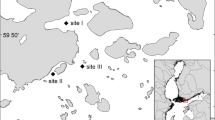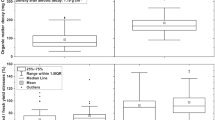Abstract
A region of hypoxic waters has formed annually over the past several decades in the northern Gulf of Mexico. This has motivated the studies of mechanisms controlling the development of hypoxia. Both field and laboratory approaches were used to examine sediment texture, erodibility, and composition. Sediment texture analyses show that grain size relates to the proximity to the Mississippi and Atchafalaya river deltas and to the remnants of shifts in the Mississippi and Atchafalaya deltaic lobes. Temporal variability in erodibility relates to seasonal weather patterns, with more energetic wave conditions in winter and spring setting up an active bottom layer that increases erodibility, compared to quiescent summers that allow for seabed consolidation. The amount of eroded material is fairly low until shear stress levels in the bottom boundary layer exceed 0.4 Pa. An organically enriched fluff layer was found at the sediment–water interface, which is highly erodible under low shear stress levels. Eroded volatile suspended solids (a proxy for organic material) vs. increasing levels of shear stress revealed a distinct pattern at all sample areas; higher concentrations of organic material were eroded at the lowest (0.01 Pa) and highest (0.6 Pa) applied shear stresses, and there was a higher ratio of the volatile to total suspended solids at 0.01 Pa. Based on erodibility experiments and modeling data analysis, the low shear stress levels during the quiescent periods in summer were sometimes high enough to resuspend this fluff layer, but not underlying sediment, thereby potentially facilitating the development of bottom water hypoxia.













Similar content being viewed by others
References
Briggs K, Watkins J, Shivarudrappa S, Hartman V (2009) Effects of hypoxia on sediment properties in the northern Gulf of Mexico. Naval Research Laboratory Public Records
Brown AC, McLachlan A (1990) Ecology of sandy shores. Elsevier Science Publishing Company, Inc., New York, p 328
Buczkowski BJ, Reid JA, Jenkins CJ, Reid JM, Williams SJ, Flocks JG (2006) usSEABED: Gulf of Mexico and Caribbean (Puerto Rico and U.S. Virgin Islands) offshore surficial sediment data release: U.S. Geological Survey Data Series 146, version 1.0.
Christainsen C, Edelvang K, Emeis K, Graf G, Jahmlich S, Kozuch J, Laima M, Leipe T, Loffler A, Lund-Hansen LC, Miltner A, Pazdro K, Pempkowiak J, Shimmield G, Shimmield T, Voss M, Witt G (2002) Material transport from the nearshore to the basinal environment in the southern Baltic Sea I. Processes and mass estimates. J Mar Syst 35:133–150
Coleman JM, Gagliano SM (1964) Cyclic sedimentation in the Mississippi River deltaic plain. Trans—Gulf Coast Assoc Geol Soc XIV:67–80
Coleman JM, Roberts HH, Stone GW (1998) Mississippi River delta: an overview. J Coast Res 14(3):698–716
Dagg M, Sato R, Liu H, Bianchi T, Green R, Powell R (2008) Microbial food web contributions to bottom water hypoxia in the Northern Gulf of Mexico. Cont Shelf Res 28:1127–1137
Dalyander PS, Butman, Bradford, Sherwood CR, Signell RP (2012) Documentation of the U.S. Geological survey sea floor stress and sediment mobility database: U.S. Geological survey open file report 2012–1137. http://pubs.usgs.gov/of/2012/1137
Dickhudt PJ, Friedrichs CT, Schaffner LC, Sanford LP (2009) Spatial and temporal variation in cohesive sediment erodibility in the York River estuary, eastern USA: a biologically influenced equilibrium modified by seasonal deposition. Mar Geol 267:128–140
Draut AE, Kineke GC, Velasco DW, Allison MA, Prime RJ (2005) Influence of the Atchafalaya river on recent evolution of the chenier-plain inner continental shelf, northern Gulf of Mexico. Cont Shelf Res 25:91–112
Emeis K, Christainsen C, Edelvang K, Jahmlich S, Kozuch J, Laima M, Leipe T, Loffler A, Lund-Hansen LC, Miltner A, Pazdro K, Pempkowiak J, Pollehne F, Shimmield T, Voss M, Witt G (2002) Material transport from the near shore to the basinal environment in the southern Baltic Sea II: synthesis of data on origin and properties of material. J Mar Syst 35:151–168
Environmental Protection Agency. http://water.epa.gov/type/watersheds/named/msbasin/marb.cfm. Accessed 8 Oct 2014
Gardner WS, McCarthy MJ, Carini SA, Souza AC, Lijun H, McNeal KS, Puckett MK, Penningtion J (2009) Collection of intact sediment cores with overlying water to study nitrogen- and oxygen-dynamics in regions with seasonal hypoxia. Cont Shelf Res 29:2207–2213
Grant J, Emerson CW, Hargrave BT, Shortle JL (1991) Benthic oxygen consumption on continental shelves off Eastern Canada. Cont Shelf Res 11:1083–1097
Gust G, Muller V (1997) Interfacial hydrodynamics and entrainment functions of currently used erosion devices. Cohesive Sediments 149–174
Johnson AG, Kelley JT (1984) Temporal, spatial, and textural variation in mineralogy of Mississippi river suspended sediment. J Sediment Petrol 54(1):0067–0072
Lo EL, Bentley SJ, Xu K (2014) Experimental study of cohesive sediment consolidation and resuspension identifies approaches for coastal restoration: Lake Lery, Louisiana. Geo-Mar Lett. doi:10.1007/s00367-014-0381-3
Maa JPY, Sanford L, Halka JP (1998) Sediment resuspension characteristics in Baltimore Harbor, Maryland. Mar Geol 146:137–145
McKee BA, Aller RC, Allison MA, Bianchi TS, Kineke GC (2004) Transport and transformation of dissolved and particulate materials on continental shelf margins influenced by major rivers: benthic boundary layer and seabed processes. Cont Shelf Res 24:899–926
Meade RH, Moody JA (2010) Causes for the decline of suspended-sediment discharge in the Mississippi river system, 1940–2007. Hydrol Process 24:35–49
Milligan TG, Law BA (2013) Contaminants at the sediment-water interface: implications for environmental impact assessment and effects monitoring. Environ Sci Technol 47:5828–5834
Murrell MC, Lehrter JC (2010) Sediment and lower water column oxygen consumption in the seasonally hypoxic region of the Louisiana continental shelf. Estuar Coasts 34(5):912–924
NOAA. Gulf of Mexico Data Atlas. http://gulfatlas.noaa.gov/. Accessed 26 June 2013
Orton GJ, Reading HG (1993) Variability of deltaic processes in terms of sediment supply, with particular emphasis on grain size. Sedimentol 40:475–512
Quinones-Rivera ZJ, Wissel B, Justic D, Fry B (2007) Partitioning oxygen sources and sinks in a stratified, eutrophic coastal ecosystem using stable oxygen isotopes. Mar Ecol Prog Ser 342:69–83
Rabalais NN, Turner RE, Sen Gupta BK, Boesch DF, Chapman P, Murrell MC (2007) Characterization and long-term trends of hypoxia in the Northern Gulf of Mexico: does the science support the plan to reduce, mitigate, and control hypoxia? Estuar Coasts 30(5):753–772
Rowe GT, Cruz Kaegi ME, Morse JW, Boland GS, Escobar Briones EG (2002) Sediment community metabolism associated with continental shelf hypoxia, Northern Gulf of Mexico. Estuar 25:1097–1106
Sanford LP, Maa JPY (2001) A unified erosion formulation for fine sediments. Mar Geol 179:9–23
Schaaff E, Grenz C, Pinazo C, Lansard B (2006) Field and laboratory measurements of sediment erodibility: a comparison. J Sea Res 55:30–42
Shepard RG (1989) Correlations of permeability and grain size. Groundw 27:663–668
Turner RE, Rabalais NN, Justic D (2006) Predicting summer hypoxia in the Northern Gulf of Mexico: riverine N, P, and Si loading. Mar Pollut Bull 52(2):139–148
Turner RE, Rabalais NN, Justic D (2008) Gulf of Mexico hypoxia: alternate states and a legacy. Environ Sci Technol 42:2323–2327
United States Army Corps of Engineers. http://www2.mvn.usace.army.mil/cgi-bin/wcmanual.pl?01100 (Mississippi water discharge). Accessed 8 Oct 2014
United States Geological Survey. http://waterdata.usgs.gov/la/nwis/inventory/?site_no=07295100&agency_cd=USGS& (Mississippi sediment discharge). Accessed 8 October 2014; http://waterdata.usgs.gov/la/nwis/nwisman/?site_no=07381490&agency_cd=USGS (Atchafalaya water and sediment discharge). Accessed 8 Oct 2014
Vousdoukas MI, Verney R, Dufois F, Pinazo C, Sauzade D, Meule S, Cann P, Plomaritis TA (2011) Sediment dynamics in the Bay of Marseille, Gulf of Lions (France): hydrodynamic forcing vs. bed erodibility. J Coast Res 27(5):942–958
Wainright SC, Hopkinson CS Jr (1997) Effects of sediment resuspension on organic matter processing in coastal environments: a simulation model. J Mar Syst 11:353–368
Xu K, Harris CK, Hetland RD, Kaihatu JM (2011) Dispersal of Mississippi and Atchafalaya sediment on the Texas-Louisiana shelf: model estimates for the year 1993. Cont Shelf Res 31:1558–1575
Xu KH, Corbett DR, Walsh JP, Young D, Briggs KB, Cartwright GM, Friedrichs CT, Harris CK, Mickey RC, Mitra S (2014) Seabed erodibility variations on the Louisiana continental shelf before and after the 2011 Mississippi River flood. Estuar Coast Shelf Sci. doi:10.1016/j.ecss.2014.09.002
Acknowledgments
We would like to acknowledge all the participants who helped in field, laboratory, and modeling work. This study was funded through multiple grants provided by the U.S. National Oceanic and Atmospheric Administration (NA09N0S4780208, contribution # xxx), National Science Foundation (OCE-1142557), and Coastal Carolina University. Much appreciation is given to the principal investigators and students who are part of the Mechanisms Controlling Hypoxia (MCH) research group for their research efforts. Special thanks are given to the crew of the R/V Pelican and Cape Hatteras for their field assistance and to Preston O’Brien-Gayes, Brain Quigley, and Kyle St. Clair for their help with field and laboratory analyses.
Author information
Authors and Affiliations
Corresponding author
Additional information
Responsible Editor: Lawrence P. Sanford
This article is part of the Topical Collection on the 12th International Conference on Cohesive Sediment Transport in Gainesville, Florida, USA, 21–24
Rights and permissions
About this article
Cite this article
Mickey, R., Xu, K., Libes, S. et al. Sediment texture, erodibility, and composition in the Northern Gulf of Mexico and their potential impacts on hypoxia formation. Ocean Dynamics 65, 269–285 (2015). https://doi.org/10.1007/s10236-014-0796-4
Received:
Accepted:
Published:
Issue Date:
DOI: https://doi.org/10.1007/s10236-014-0796-4




